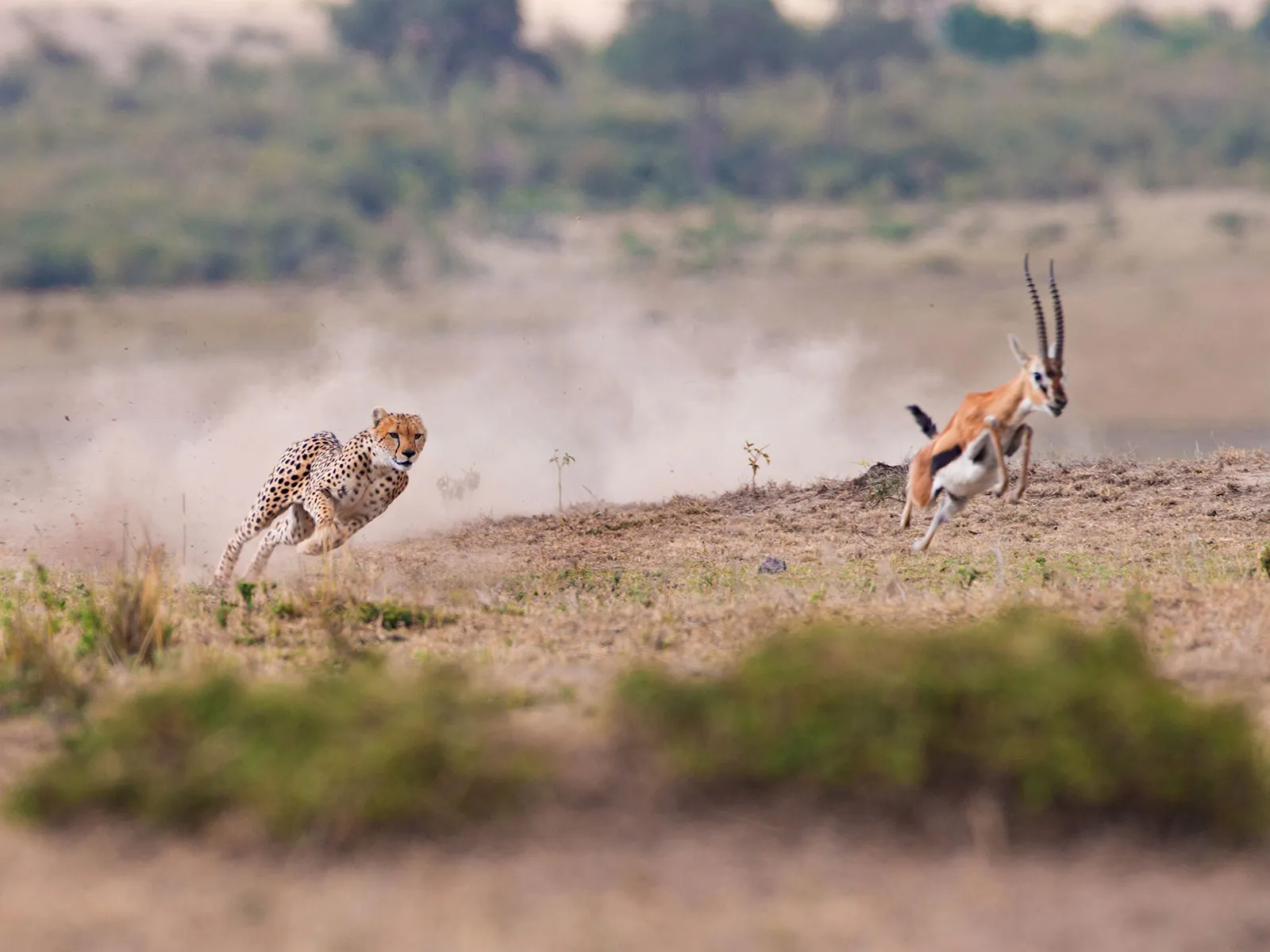Contents
Understanding the natural instincts of game animals: are they purely prey animals?

Game animals are a diverse group of creatures, ranging from large mammals like deer and elk to small birds and rodents. These animals have long been sought after by hunters for their meat, fur, and other resources.
One of the key characteristics of game animals is that they are prey animals. This means that they are constantly on guard, watching for potential threats from predators. Their survival depends on their ability to detect danger and quickly react to it.
The natural instincts of game animals play a crucial role in their survival. For example, their keen sense of hearing allows them to detect the faintest sounds of approaching predators. Their sharp vision helps them spot movements in the distance, even in low light conditions. Additionally, their ability to run swiftly and jump high enables them to escape from dangerous situations.
Understanding the natural instincts of game animals is essential for hunters, as it allows them to anticipate the behavior of their quarry. By studying the behavior and habits of these animals, hunters can increase their chances of success and develop a greater appreciation for the remarkable adaptations that have allowed game animals to thrive in a world filled with predators.
Game animals: Characteristics and behavior
Game animals, especially prey animals, have unique characteristics and behaviors that are important to understand when it comes to hunting and conservation efforts. These animals have evolved over time to adapt to the constant threat of predators and have developed various survival mechanisms.
One of the key characteristics of game animals is their keen senses. Prey animals have excellent eyesight, hearing, and sense of smell, allowing them to detect predators from a distance. This helps them to stay alert and avoid potential threats.
Another important behavior of game animals is their ability to camouflage. Many prey animals have evolved natural coloration and patterns that blend into their surroundings, making it difficult for predators to spot them. This camouflage is especially important during times of vulnerability, such as when females are giving birth or when young animals are learning to fend for themselves.
Game animals also exhibit social behavior, especially when it comes to mating and raising their young. Many species form herds or groups, providing safety in numbers. Males often compete for the attention of females through displays of strength or elaborate courtship rituals.
When it comes to migration, game animals are known for their incredible instinct and ability to navigate long distances. They can sense changes in the environment and follow specific routes to reach their seasonal breeding grounds or to find food sources.
Furthermore, game animals possess remarkable agility and speed, allowing them to evade predators. They can quickly change direction or leap over obstacles to escape danger. This agility is especially crucial for animals such as deer or antelope that inhabit open grasslands or forests.
In conclusion, game animals, as prey species, have developed unique characteristics and behaviors throughout evolution to survive in their environments. By understanding these traits, hunters and conservationists can contribute to responsible and sustainable management of game populations.
Herbivorous diet and foraging behavior

Game animals are typically herbivores, meaning that their diet consists primarily of plants and vegetation. They rely on their ability to forage for food in order to sustain themselves and survive in their natural habitats.
As prey animals, game species have evolved specific instincts and behaviors when it comes to finding and consuming their food. They have developed a keen sense of smell and taste, allowing them to detect and select the most nutritious plants. They also have specialized digestive systems that enable them to extract maximum nutrients from the vegetation they consume.
In terms of foraging behavior, game animals display a range of strategies to locate food sources. They may graze on grasses and low-lying plants, using their sharp teeth and agile tongues to efficiently eat and process the vegetation. Some species, such as deer, are known to browse on leaves and twigs, reaching up to higher branches to obtain their food.
Game animals also exhibit a certain degree of selectivity in their feeding habits. They have the ability to distinguish between different plant species and will choose those that offer the highest nutritional value. This helps them to maintain their health and energy levels, which are crucial for survival in the wild.
Overall, understanding the herbivorous diet and foraging behavior of game animals is essential for conservation efforts and wildlife management. By studying these natural instincts, researchers and wildlife managers can gain insights into the nutritional needs and ecological requirements of these species, helping to ensure their survival and well-being in their natural habitats.
Game animals, like many other animals, often live in groups and form social hierarchies. These group dynamics and social structures play a crucial role in the survival and reproduction of the animals.
In group dynamics, animals interact with each other and establish their roles within the group. This can include behaviors such as dominance displays, aggression, or cooperation. By participating in these interactions, animals establish a social hierarchy where individuals are ranked based on their social status and power.
The social hierarchy within game animal groups can have a significant impact on the individuals’ access to food, mating opportunities, and overall survival. Higher-ranking individuals often have priority access to resources and favorable mating partners.
However, social hierarchies are not static and can change over time. Dominant individuals may be challenged by subordinates, leading to shifts in the social structure. These challenges can happen through vigorous fights or by subtle displays of dominance.
Understanding the group dynamics and social hierarchy of game animals is essential for wildlife managers and hunters. By understanding the roles and interactions within the group, they can better manage populations and make informed decisions regarding hunting quotas and population control measures.
In conclusion, game animals have complex group dynamics and social hierarchies. These dynamics play a crucial role in the survival and reproductive success of the animals. By understanding these dynamics, we can gain insights into their behavior and make informed management decisions.
Prey animals, such as game animals, have developed remarkable seasonal migration patterns and navigation abilities. These instincts allow them to find suitable habitats and resources throughout different seasons, ultimately ensuring their survival.
During the changing seasons, prey animals often migrate from one area to another in search of food, water, or better climate conditions. This movement can be observed in various species, including herbivores like deer, elk, and migratory birds.
Migration patterns are typically influenced by environmental factors such as temperature, food availability, and predation pressure. For example, when winter arrives and food becomes scarce in their current habitat, game animals may travel long distances to find areas with better forage options.
Navigation abilities play a crucial role in the success of seasonal migration. Prey animals, relying on their senses and memory, often use landmarks, celestial cues, and magnetic fields to navigate and find their way. Some species may also communicate with each other during migration, forming groups and following leaders to reach their destination.
Researchers have found that prey animals possess an innate ability to sense the Earth’s magnetic field, allowing them to orient themselves and travel in the right direction. This magnetic sense is thought to be influenced by the presence of special cells in their bodies, which act as natural compasses.
Overall, the ability of prey animals to migrate and navigate seasonally showcases their incredible adaptations to survive and thrive in different environments. Studying these patterns and abilities can provide valuable insights into the natural instincts and behaviors of game animals.
Predation and survival strategies

Animals that are considered prey have developed various survival strategies to avoid predation. These strategies are crucial for their survival in the wild.
One common strategy is camouflage, where prey animals blend into their surrounding environment to avoid being seen by predators. This can include having fur or feathers that match the colors and patterns of their habitats. Some prey animals even have the ability to change their skin color to match their surroundings.
Another important strategy is agility and speed. Prey animals often have well-developed muscles and are capable of quick movements, allowing them to escape from predators. For example, gazelles have long legs that enable them to run at high speeds to evade predators like cheetahs.
Prey animals also rely on their senses to detect predators. They have acute hearing, sight, and smell, which help them detect potential threats. Some prey animals, like deer, have ears that can rotate to locate the source of the sound, and eyes positioned on the sides of their heads to provide a wide field of vision.
In addition to physical adaptations, prey animals also use behavioral strategies to increase their chances of survival. For instance, they often live in groups, which allows them to have a better chance of detecting predators and sounding alarm calls to warn the rest of the group. They may also engage in mobbing behavior, where they form a group and aggressively confront predators to protect themselves.
Overall, prey animals have evolved various strategies to survive in their predator-rich environments. Whether it’s through physical adaptations, such as camouflage and agility, or behavioral strategies, like living in groups and using alarm calls, these animals have found ways to increase their chances of survival.
Camouflage and hiding techniques
In order to survive in their natural environments, prey game animals have developed various camouflage and hiding techniques. These techniques not only help them avoid detection by predators but also allow them to blend in with their surroundings, making it easier for them to catch their own prey.
| Technique | Description |
|---|---|
| Camouflage | Prey game animals have evolved to have colors and patterns that match their surroundings. This allows them to blend in and become almost invisible to predators. For example, deer can have coats that mimic the colors of the forest, making them difficult to spot among the trees and foliage. |
| Counter-shading | Many prey game animals, such as rabbits and hares, have fur that is lighter on their undersides and darker on their backs. This coloration helps to break up their shape and makes it harder for predators to spot them, especially when they are in motion. |
| Disruptive coloration | Some prey game animals have patterns that break up their body outline. This makes it difficult for predators to distinguish the individual animal from its surroundings. For example, some birds have feathers with stripes or spots that help them blend in with tree branches. |
| Behavioural camouflage | Prey game animals also use certain behaviors to hide from predators. For example, they may freeze in place when they sense danger, relying on their ability to blend in with their surroundings to remain undetected. They may also use natural structures, such as burrows or fallen logs, to hide and take cover. |
Overall, the camouflage and hiding techniques employed by prey game animals are essential for their survival. By blending in with their surroundings and using various coloration patterns and behaviors, they are able to avoid becoming prey themselves and continue to thrive in their natural habitats.
Vigilance and early warning systems
Prey animals, such as game animals, have developed a keen sense of vigilance and early warning systems to survive in their natural habitats. These instinctive behaviors help them detect potential threats and react quickly to ensure their safety.
One of the key strategies prey animals employ is maintaining constant vigilance. They are constantly scanning their surroundings, using their senses of sight, smell, and hearing to detect any signs of danger. Their acute senses allow them to spot predators from a distance and assess the level of threat they pose.
In addition to vigilance, prey animals also rely on early warning systems. This involves communication between members of the group to alert each other to potential danger. They use various signals, such as vocalizations, body postures, and gestures, to convey information about the presence of predators or other threats. This collective vigilance increases the chances of detecting danger and allows the group to respond collectively to protect themselves.
Furthermore, some prey animals have developed specialized adaptations to enhance their early warning systems. For example, certain species have evolved large ears or eyes that allow them to detect predators even in dim light or dense vegetation. Others have developed camouflage or warning colors to blend in with their surroundings or signal their unpalatability to predators.
The vigilance and early warning systems of prey animals play a crucial role in their survival. By being constantly on the lookout for danger and communicating effectively with one another, they are able to avoid becoming easy targets for predators. Understanding these natural instincts is essential for conservation efforts and can inform management strategies to ensure the continued survival of game animals and other prey species in their habitats.
Speed, agility, and evasive maneuvers
Game animals, as prey animals, have astonishing speed, agility, and evasive maneuvers that allow them to escape from predators. These traits have evolved over time as a survival mechanism to evade capture and ensure their survival in the wild.
When a game animal senses danger, such as the presence of a predator, their instincts kick in, triggering a series of rapid responses. Their acute senses, including sight, hearing, and smell, help them detect threats from a distance.
Once a game animal detects a predator, they will immediately use their speed and agility to outrun and outmaneuver their would-be attacker. These prey animals can reach incredible speeds, allowing them to quickly put distance between themselves and the predator.
In addition to their speed, game animals are masters of agility. They can swiftly change direction, making sharp turns and darting through dense vegetation with ease. This agility helps them confuse and elude their pursuers, giving them the upper hand in evading capture.
Moreover, game animals employ various evasive maneuvers to avoid detection and capture. They may engage in camouflage, blending with their surroundings to become nearly invisible. Some prey animals exhibit behavior known as “freeze response,” where they remain perfectly still, hoping that the predator will overlook them.
Another tactic employed by game animals is the use of decoys and diversionary tactics to confuse predators. By creating distractions, such as false alarm calls or intentional movements away from their young or group, game animals can divert predators’ attention and escape unnoticed.
The combination of speed, agility, and evasive maneuvers makes game animals formidable prey, capable of evading capture by even the most skilled predators. These traits have developed through evolution and are crucial for their survival in the natural world.
Instinctual responses to threats

Game animals have evolved various instinctual responses to handle threats in their natural environment. These responses ensure their survival in the face of danger.
When faced with a predator or threat, game animals rely on their acute senses to detect danger. Their sense of sight, hearing, and smell helps them identify predators at a distance. They may freeze, remain motionless, and blend into their surroundings, hoping to go unnoticed. This instinctual response helps them avoid detection and potential attack.
If the threat persists or gets closer, game animals may resort to a defensive response. They may stamp their hooves or produce loud vocalizations to intimidate the predator and establish dominance. Some game animals, like deer, may also use their antlers as weapons to defend themselves or engage in physical confrontations.
In critical situations, game animals may resort to flight as a last-ditch effort to escape the threat. Their strong legs and agile bodies allow them to run swiftly through their natural habitat, evading predators and seeking safety. This flight response is crucial for their survival, as it increases their chances of outrunning predators.
Overall, game animals possess a remarkable range of instinctual responses to threats. Their ability to detect danger, camouflage, intimidate, and flee ensures their survival in the face of various predators and threats in the wild.
Freeze, flight, or fight: Assessing the danger

Prey animals in the wild have instinctual responses to assess danger and determine the best course of action. When faced with a potential threat, these animals rely on their instincts to decide whether to freeze, flee, or engage in combat.
The freeze response is commonly observed in prey animals when they feel threatened. By staying perfectly still, these animals hope to blend into their surroundings and go unnoticed by predators. This instinctual behavior buys them time to assess the situation and determine if the threat is imminent or non-threatening.
Flight is another instinctual response that many prey animals exhibit when they sense danger. These animals are built for speed and agility, making them well-equipped to outrun potential predators. By fleeing from the danger, prey animals increase their chances of survival and decrease the risk of a direct confrontation.
While freezing and fleeing are common responses, some prey animals may choose to fight when confronted with a threat. This instinctual response is typically seen when escape is not a viable option or when protecting their young. Prey animals may exhibit aggressive behavior, such as charging, kicking, or using their horns or antlers, in an attempt to fend off the predator.
To better understand the danger and assess the appropriate response, prey animals rely on their senses, including sight, smell, and hearing. These heightened senses help them detect potential threats and make split-second decisions to ensure their survival.
In conclusion, prey animals possess a range of instinctual responses to assess danger and choose the most appropriate course of action. Whether it’s freezing, fleeing, or fighting, these animals rely on their natural instincts to increase their chances of survival in the wild.

A skilled hunter, dedicated conservationist, and advocate for ethical practices. Respected in the hunting community, he balances human activity with environmental preservation.
